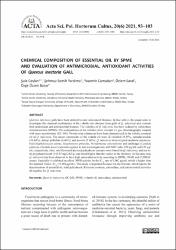| dc.contributor.author | Ceylan, Şule | |
| dc.contributor.author | Yardımcı, Şehmuz Semih | |
| dc.contributor.author | Camadan, Yasemin | |
| dc.contributor.author | Saral, Özlem | |
| dc.contributor.author | Batur, Özge Özsen | |
| dc.date.accessioned | 2022-09-08T12:47:46Z | |
| dc.date.available | 2022-09-08T12:47:46Z | |
| dc.date.issued | 2021 | en_US |
| dc.identifier.citation | Ceylan, S., Yardimci, S.S., Camadan, Y., Saral, O. & Batur, O.O. (2021). Chemical composition of essential oil by spme and evaluation of antimicrobial, antioxidant activities of quercus inectoria gall. Acta Scientiarum Polonorum-Hortorum Cultus, 20(6), 93-103. https://doi.org/10.24326/asphc.2021.6.10 | en_US |
| dc.identifier.issn | 1644-0692 | |
| dc.identifier.issn | 2545-1405 | |
| dc.identifier.uri | https://doi.org/10.24326/asphc.2021.6.10 | |
| dc.identifier.uri | https://hdl.handle.net/11436/6418 | |
| dc.description.abstract | Quercus infectoria galls have been utilized to cure widespread illnesses. In line with it, this paper aims to investigate the chemical combination of the volatile oils obtained from galls of Q. infectoria and evaluate their antioxidant and antimicrobial features. The volatiles of Q. infectoria has been isolated by solid-phase microextraction (SPME). The compositions of the volatiles were revealed via gas chromatography coupled with mass spectrometry (GC-MS). Twenty-nine substances have been characterized in the volatile essential oil of Q. infectoria. The major components of the volatile oil were (Z)-Anethol 28.55%, pentadecanolide (26.44%), diethyl phthalate (6.46%), and acetoin (5.66%). Q. infectoria showed good-moderate antimicrobial (Staphylococcus aureus, Streptomyces griseolus, Pseudomonas citronellosis) and antifungal (Candida glabrata, Candida krusei) activities against to test microorganisms with MIC value 250 mu g/mL and 125 mu g/mL, respectively. Also, total flavonoid and total polyphenol amounts were found for Q. infectoria, and our total polyphenol result (342.87 mg GAE/g) was found higher than the studies in the literature. At the same time Q. infectoria has been observed to have high antioxidant activity according to DPPH, FRAP, and CUPRAC assays. Especially it exhibited excellent DPPH activity for the IC50 rate of 0.002 mu g/mL which is higher than the standard Trolox (IC50=0.008 mu g/mL). This study is important because it is the first one, which reports the determination of essential oil, total polyphenol, flavonoid contents, antioxidant, and antimicrobial activities all together for Q. infectoria. | en_US |
| dc.language.iso | eng | en_US |
| dc.publisher | University of Life Sciences in Lublin | en_US |
| dc.rights | info:eu-repo/semantics/openAccess | en_US |
| dc.subject | Quercus infectoria | en_US |
| dc.subject | GC-MS | en_US |
| dc.subject | SPME | en_US |
| dc.subject | Volatile oil | en_US |
| dc.subject | Antioxidant | en_US |
| dc.subject | Antimicrobial | en_US |
| dc.title | Chemical composition of essential oil by SPME and evaluation of antimicrobial, antioxidant activities of Quercus inectoria gall | en_US |
| dc.type | article | en_US |
| dc.contributor.department | RTEÜ, Sağlık Yüksekokulu, Beslenme ve Diyetetik Bölümü | en_US |
| dc.contributor.institutionauthor | Saral, Özlem | |
| dc.identifier.doi | 10.24326/asphc.2021.6.10 | en_US |
| dc.identifier.volume | 20 | en_US |
| dc.identifier.issue | 6 | en_US |
| dc.identifier.startpage | 93 | en_US |
| dc.identifier.endpage | 103 | en_US |
| dc.relation.journal | Acta Scientiarum Polonorum-Hortorum Cultus | en_US |
| dc.relation.publicationcategory | Makale - Uluslararası Hakemli Dergi - Kurum Öğretim Elemanı | en_US |


















